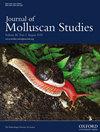Shell shape as a potential predictor of age class in the invasive snail Lissachatina fulica
IF 1.2
4区 生物学
Q2 MARINE & FRESHWATER BIOLOGY
引用次数: 0
Abstract
Understanding the life-history traits of invasive species can increase the effectiveness of eradication efforts and decrease costs. In the giant African snail Lissachatina fulica, one of the 100 worst invasive species on the planet, age structure can be an important indicator of invasiveness. Here, we associated variation in snail size with variation in weight and shell shape, in an effort to better understand the growth pattern in this species. Our study involved two components: we estimated the allometric relationship between weight and length in a natural population and monitored developmental variation in snail shape, weight, length and nutritional condition (condition factor) in a lab population. The weight and length growth patterns of the lab population were estimated independently using exponential regressions based on weekly measurements; shell shape was quantified using geometric morphometrics. In both populations, we found negative allometry between weight and length, suggesting that snail shells tend to elongate during growth. Geometric morphometrics confirmed this pattern and revealed that the change from a rounded to an elongated shell shape does not occur at a constant pace but during a specific growth interval (i.e. at a shell length of 55–65 mm), which is described in the literature as the size when the animal becomes hermaphroditic. Future studies should test whether the shape change reported here corresponds to the transition to the hermaphrodite age class, and with this in mind, we provide two simple morphological indexes that allow us to characterize shell shape as rounded or elongated. If shell size and shape are indicative of the transition to the hermaphroditism, then our findings can help to place individuals of L. fulica into appropriate age classes, and this will represent a useful baseline for development of eradication policies.壳形作为入侵蜗牛Lissachatina fulica年龄等级的潜在预测因子
了解入侵物种的生活史特征可以提高根除工作的有效性并降低成本。非洲巨型蜗牛Lissachatina fulica是地球上100种最严重的入侵物种之一,年龄结构可以作为入侵的重要指标。在这里,我们将蜗牛大小的变化与体重和壳形状的变化联系起来,以便更好地了解该物种的生长模式。我们的研究包括两个部分:我们估计了自然种群中蜗牛的体重和长度之间的异速生长关系,并监测了实验室种群中蜗牛形状、体重、长度和营养状况(条件因子)的发育变化。利用基于每周测量的指数回归,独立估计实验室种群的体重和长度增长模式;采用几何形态计量学对壳体形状进行量化。在这两个种群中,我们发现体重和长度之间存在负异速,这表明蜗牛壳在生长过程中倾向于拉长。几何形态计量学证实了这一模式,并揭示了从圆形到细长外壳形状的变化不是以恒定的速度发生的,而是在特定的生长间隔(即外壳长度为55-65 mm)期间发生的,这在文献中被描述为动物变为雌雄同体时的大小。未来的研究应该测试这里报道的形状变化是否对应于向雌雄同体时代的过渡,考虑到这一点,我们提供了两个简单的形态学指标,使我们能够将壳的形状表征为圆形或细长。如果壳的大小和形状是向雌雄同体过渡的标志,那么我们的研究结果可以帮助将白桦尺蠖的个体划分到适当的年龄类别,这将为制定根除政策提供有用的基线。
本文章由计算机程序翻译,如有差异,请以英文原文为准。
求助全文
约1分钟内获得全文
求助全文
来源期刊

Journal of Molluscan Studies
生物-动物学
CiteScore
3.00
自引率
8.30%
发文量
36
审稿时长
3 months
期刊介绍:
The Journal of Molluscan Studies accepts papers on all aspects of the study of molluscs. These include systematics, molecular genetics, palaeontology, ecology, evolution, and physiology. Where the topic is in a specialized field (e.g. parasitology, neurobiology, biochemistry, molecular biology), submissions will still be accepted as long as the mollusc is the principal focus of the study, and not incidental or simply a convenient experimental animal. Papers with a focus on fisheries biology, aquaculture, and control of molluscan pests will be accepted only if they include significant advances in molluscan biology. While systematic papers are encouraged, descriptions of single new taxa will only be considered if they include some ‘added value’, for example in the form of new information on anatomy or distribution, or if they are presented in the context of a systematic revision or phylogenetic analysis of the group.
 求助内容:
求助内容: 应助结果提醒方式:
应助结果提醒方式:


